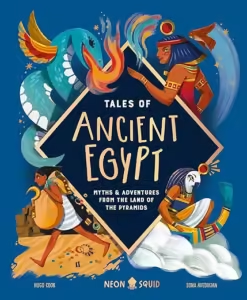Tales of Ancient Egypt
Hugo D. Cook
Illustrated by Sona Avedikian
Neon Squid
Published October 1, 2024
Amazon | Bookshop | Goodreads
About Tales of Ancient Egypt
Discover amazing true stories and breathtaking myths from ancient Egypt in this book by TikTok Egyptologist Hugo Cook, featuring stunning illustrations from Sona Avedikian.
Everyone knows the story of Tutankhamun, but the ancient Egyptian civilization lasted for more than 3,000 years – which means there are loads more amazing tales to be told! Egyptologist and TikTok star Hugo Cook (aka Hugo the Egyptologist) has scoured ancient texts and translated hieroglyphs to bring readers stories of love, betrayal, and royal scandal featuring pharaohs, priests, gods, and goddesses.
The book combines historical stories, including the time Cleopatra hid in a sack to be smuggled into a palace to meet Julius Caesar, with rip-roaring myths, like the Cinderella story of a peasant girl who married the pharaoh when he found her slipper.
Told with great fun and impeccably researched, readers will slip into a tomb at night with a band of mischievous tomb robbers and witness epic battles featuring elephants and ostriches. Interspersed through the stories are pages explaining the history of ancient Egypt on the banks of the Nile, from how pyramids were built to a step-by-step guide to wrapping a mummy.
With a beautiful cloth-textured cover featuring shiny foil, Tales of Ancient Egypt is the perfect gift for kids interested in ancient Egypt.
My Review
My older daughter would have absolutely loved this book when she was in later elementary school. She had a couple of books on mythology and folklore, but we didn’t have anything on ancient Egypt.
Almost all the stories or fact collections are limited to a single spread, which makes this book easy to read even for readers intimidated by its size (the hardcover edition is 9.25″ x 11.25″ and 151 pages). Each spread shows brightly colored illustrations featuring characters with expressive faces. The backmatter includes a glossary and a list of deities. One of the things I wish it also included are some recommendations for further reading.
The book includes both historical accounts and facts as well as mythological tales. Myths are labeled as such to avoid any confusion. I liked the mix of the two as they often added context to one another. For example, the story of Khaemweset includes some factual information as context and then transitions to the myths about him.
This is a book that kids interested in mythology or history will enjoy. The format makes the information easily accessible and entertaining while offering many cool historical tidbits. I can see this being a book that I give for Christmas this year.
Content Notes for Tales of Ancient Egypt
Recommended for Ages 8 to 12.
Representation
Stories feature characters from Egyptian mythology, famous ancient Egyptians, and facts about ancient Egyptian life.
Profanity/Crude Language Content
None.
Romance/Sexual Content
References to love and romantic partnership.
Spiritual Content
Contains stories of Egyptian mythology and ancient Egypt’s pantheon of gods. Some mythological stories contain characters who perform magic or sorcery.
Violent Content
Stories contain situations of peril and brief references to murder or attempted murder, especially via poison or stabbing. One illustration shows a wincing Cleopatra allowing a snake to bite her hand. No gory descriptions. Brief description of the process of mummification. Someone tells a man to throw murder his children, and he tosses them out a high window. Later, he realizes this was a nightmare. Crocodiles devour an army trying to cross the Nile.
Drug Content
References to drinking beer. Several instances of death by poisoning.
Note: This post contains affiliate links, which do not cost you anything to use but help support this blog. I received a free copy of this book in exchange for my honest review. All opinions are my own.
